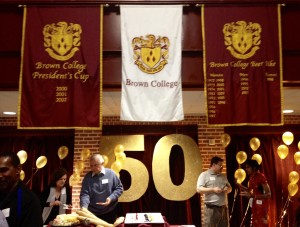Brown College 50th Anniversary

Rice University has no sororities or fraternities, seeking instead to foster gracious living at residential colleges, each with a complement of Resident, Faculty, and Community Associates. For three years I lived in Jones College, to which all Rice women had been assigned. For our senior year several of my friends and I volunteered to be pioneers at a new women’s college named for the sister-in-law of George and Alice Brown. George Brown and his brother Herman, early supporters of Lyndon Baines Johnson, founded Brown & Root, a construction company now known as KBR, which built the Manned Spacecraft Center near Houston. Margarett Root Brown died in 1963; construction on the new college began in 1964. In the spring of 1965 I was elected the first President of Margarett Root Brown College. My roommate Carolyn Cox was the Social Chair and my friend Elizabeth Vickery chaired Programs. While Steve and I were at Rice for his 50th Reunion last week, I had the honor of speaking at Brown’s 50th anniversary celebration.
Planning for a new college during the spring of my junior year was sheer fun. The architects asked for input, which we freely gave. Alice Brown entertained the newly-elected cabinet in her home, an unpretentious, but comfortable place in River Oaks, crammed with art, books, Oriental rugs and travel treasures. Hers was a style to which I still aspire. Alice regaled us with stories of the Browns’ stays in the Lincoln Bedroom at Johnson’s White House and of their travels to Portugal, where she commissioned the tapestry that still hangs in the Brown lobby. I consulted a few books in Fondren Library and chose the motto for the new college, “tende bene, alta pete” (strive well, aim high). I’m still trying to live up to it.

Frank Vandiver, a Professor of Civil War History, became the first Master of Brown College at the age of 39. He and his wife Susie had three young children. Only later did I realize what a challenge it must have been for that family to move into a new house next door to 168 young women who had exceedingly high expectations of their new college. While the Vandivers had an ample supply of babysitters, there were excessive demands on a young father’s time. As a history major, I was charmed by Dr. Vandiver’s Civil War stories. Others found him paternalistic and patronizing. In the spring of 1966 Brown voted to allow women to drink alcohol in their rooms as soon as they turned 21. This attitude violated Dr. Vandiver’s conception of Southern ladies. He was horrified when that story made the front page of the Houston Chronicle. John Ambler, a Brown Faculty Associate since the beginning, commented at the 50th Anniversary celebration that that was the reason Vandiver resigned as Master after just one year. He later became the President of Texas A & M.

At Brown’s celebration of the Rice Centennial in October 2012, I met Nita Vandiver Jackson. She returned to Brown as a Rice student and later became a lawyer. Here she is with Martha Proctor, Brown President 1980-81, and Ann Patton Greene, Brown President 1970-71.
At this year’s celebration, several past masters told how Brown had evolved. I related none of the history I have written above. Nor did I introduce Steve Smith, the Baker College guy who helped me through that year and became my husband a week after graduation. I kept my remarks very brief, focusing on the successes of three members of Brown’s first Cabinet. Carolyn Cox Cohan, Social Chair in the first cabinet, has had a career as a lawyer, becoming the first woman partner at Fulbright and Jaworski, and as a professor at American University. Elizabeth Vickery Lodal, Program Chair and Rice Cheerleader, served as Principal of McLean High School and Thomas Jefferson High School for Science and Technology in Fairfax, Virginia, and now is a member of the Virginia State Board of Education. My own experience at Brown served me well as a leader in my church and as President of Music Teacher Associations at the local, state and national levels. We three have lived in the Washington DC area since the last 60s and our families remain close friends. I could have gone on and on about other Brown friends–Linda Walsh Jenkins, Carol Starr, and Carolyn Porter among others, but instead I listed the three watchwords we had that first year at Brown: civility, curiosity and creativity.
Brown went co-ed in 1987, three years after Alice Browns death, It is now the third largest of eleven residential colleges, but our original spirit remains strong. To mark this 50-year milestone, current leaders have chosen three initiatives: an outreach retreat, a creation space, and a music and digital media studio. If you would like to join me in supporting these initiatives, please visit www.brown.rice.edu/initiatives. Here are my photos from Brown’s very festive celebration of 50 years:
Leave a Reply